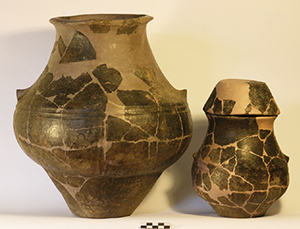Crossref Citations
This article has been cited by the following publications. This list is generated based on data provided by
Crossref.
Quinn, Colin P.
and
Fivenson, Daniel
2020.
Transforming Legacy Spatial Data into Testable Hypotheses about Socioeconomic Organization.
Advances in Archaeological Practice,
Vol. 8,
Issue. 1,
p.
65.
Duffy, Paul R.
and
Biehl, Peter F.
2020.
River networks and funerary metal in the Bronze Age of the Carpathian Basin.
PLOS ONE,
Vol. 15,
Issue. 9,
p.
e0238526.
Quinn, Colin P.
Ciugudean, Horia
Bălan, Gabriel
and
Hodgins, Gregory
2020.
Rethinking time, culture and socioeconomic organisation in Bronze Age Transylvania.
Antiquity,
Vol. 94,
Issue. 373,
p.
44.
Golitko, Mark
McGrath, Alyssa
Kreiter, Attila
Lightcap, Ian V.
Duffy, Paul R.
Parditka, Györgyi M.
and
Giblin, Julia I.
2021.
Down to the Crust: Chemical and Mineralogical Analysis of Ceramic Surface Encrustations on Bronze Age Ceramics from Békés 103, Eastern Hungary.
Minerals,
Vol. 11,
Issue. 4,
p.
436.
Staniuk, Robert
2021.
EARLY AND MIDDLE BRONZE AGE CHRONOLOGY OF THE CARPATHIAN BASIN REVISITED: QUESTIONS ANSWERED OR PERSISTENT CHALLENGES?.
Radiocarbon,
Vol. 63,
Issue. 5,
p.
1525.
Kanne, Katherine
2022.
Riding, Ruling, and Resistance.
Current Anthropology,
Vol. 63,
Issue. 3,
p.
289.
Iacono, Francesco
Borgna, Elisabetta
Cattani, Maurizio
Cavazzuti, Claudio
Dawson, Helen
Galanakis, Yannis
Gori, Maja
Iaia, Cristiano
Ialongo, Nicola
Lachenal, Thibault
Lorrio, Alberto
Micó, Rafael
Molloy, Barry
Nafplioti, Argyro
Peche-Quilichini, Kewin
Herrada, Cristina Rihuete
and
Risch, Roberto
2022.
Establishing the Middle Sea: The Late Bronze Age of Mediterranean Europe (1700–900 BC).
Journal of Archaeological Research,
Vol. 30,
Issue. 3,
p.
371.
Reed, Kelly
Hršak, Tomislav
Mihaljewić, Marija
and
Balen , Jacqueline
2022.
Settlements and cemeteries in Bronze Age Croatia: The archaeobotanical evidence.
Acta Palaeobotanica,
Vol. 62,
Issue. 2,
Polányi, Tamás
2022.
The rise of idiôtês: Micro-politics of death and community reproduction in Bronze Age Hungary.
Journal of Anthropological Archaeology,
Vol. 68,
Issue. ,
p.
101445.
Staniuk, Robert
Kreiter, Attila
Kulcsár, Gabriella
and
Jaeger, Mateusz
2022.
Uniform in diversity: Typological and technological analysis of Bronze Age fine ware from Kakucs-Turján.
Journal of Archaeological Science: Reports,
Vol. 41,
Issue. ,
p.
103332.
Laabs, Julian
2023.
Wealth Consumption, Sociopolitical Organization, and Change: A Perspective from Burial Analysis on the Middle Bronze Age in the Carpathian Basin.
Open Archaeology,
Vol. 9,
Issue. 1,
Parditka, Györgyi
and
Duffy, Paul R.
2023.
From the ashes of Bronze Age fires: A framework for comparison across body treatments.
Journal of Anthropological Archaeology,
Vol. 71,
Issue. ,
p.
101525.
DARÓCZI, TIBOR-TAMÁS
BĂLĂRIE, ANDREI
OLSEN, JESPER
and
BIRCLIN, MIROSLAV
2023.
Banatian DeathMetals: Radiocarbon Dating of Cremation Burials of the Setting Bronze Age and Dawning Iron Age.
Proceedings of the Prehistoric Society,
Vol. 89,
Issue. ,
p.
157.
Orfanou, V.
Amicone, S.
Sava, V.
O’Neill, B.
Brown, L. E. F.
Bruyère, C.
and
Molloy, B. P. C.
2023.
Forging a New World Order? Interdisciplinary Perspectives on the Management of Metalworking and Ideological Change in the Late Bronze Age Carpathian Basin.
Journal of Archaeological Method and Theory,
Vol. 30,
Issue. 2,
p.
565.
Molloy, Barry
2023.
Was There a 3.2 ka Crisis in Europe? A Critical Comparison of Climatic, Environmental, and Archaeological Evidence for Radical Change during the Bronze Age–Iron Age Transition.
Journal of Archaeological Research,
Vol. 31,
Issue. 3,
p.
331.
Dueppen, Stephen A.
and
Gallagher, Daphne
2023.
Understanding Archaeological Tells: Circulating Memories and Engaging with Ancestors through Material Attachments.
Cambridge Archaeological Journal,
Vol. 33,
Issue. 4,
p.
575.
Molloy, Barry
Jovanović, Dragan
Bruyere, Caroline
Estanqueiro, Marta
Birclin, Miroslav
Milašinović, Lidija
Šalamon, Aleksandar
Penezić, Kristina
Ramsey, Christopher Bronk
Grosman, Darja
and
Gimatzidis, Stefanos
2023.
Resilience, innovation and collapse of settlement networks in later Bronze Age Europe: New survey data from the southern Carpathian Basin.
PLOS ONE,
Vol. 18,
Issue. 11,
p.
e0288750.
Bruyère, Caroline
Molloy, Barry
Jovanović, Dragan
Birclin, Miroslav
Pendić, Jugoslav
Topić, Gordana
Milašinović, Lidija
Mirković-Marić, Neda
and
Šalamon, Aleksandar
2024.
Integrating and Dividing in a Late Bronze Age Society: Internal Organization of Settlements of the Tisza Site Group in the Southern Carpathian Basin, 1600–1200
b.c.
.
Journal of Field Archaeology,
p.
1.



